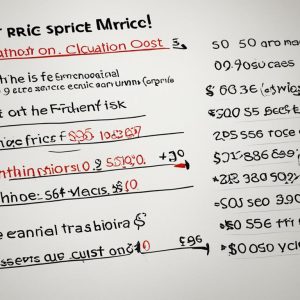The online art market is booming, providing artists with exciting opportunities to monetize their creative work. Whether you’re an established artist or just starting out, selling digital artwork can be a lucrative venture in today’s digital age. This comprehensive guide will walk you through the essential steps to successfully sell your digital art online and tap into the thriving digital art marketplace.
Key Takeaways:
- Setting up an online art business is crucial for selling digital artwork.
- Decide whether to focus on selling physical art or digital art, or both.
- Create high-quality digital files of your artwork through scanning or photography.
- Consider different pricing strategies based on production costs and market research.
- Utilize effective marketing strategies to attract customers and boost sales.
Choosing a Medium: Physical Art vs. Digital Art
Artists today have the option to sell their artwork in both physical and digital formats. Each medium has its own advantages and considerations. Let’s explore the pros and cons of selling physical art versus digital art.
Physical Art
Selling physical art offers a unique experience for both the artist and the buyer. The tangible nature of physical artwork allows for a deeper connection with the piece, as it can be seen, touched, and displayed in physical spaces. However, there are logistical challenges associated with physical art, such as production costs, shipping, and inventory management. Artists need to consider these factors when deciding to focus on physical art.
Digital Art
Digital art has gained significant popularity due to its accessibility and ease of distribution. Artists can sell digital art without the need for printing, packaging, or shipping. Additionally, digital art can be sold in infinite copies, allowing artists to reach a wider audience. Selling digital art also eliminates the risk of damage during transportation. Many artists choose to balance both physical and digital art, catering to different preferences and expanding their potential customer base.
Setting Up Your Art Business Online
Setting up an online art business is essential for artists looking to sell their digital artwork and art prints online. With the right strategies and tools, artists can reach a global audience and monetize their creations effectively. Here are some tips for selling your digital art and art prints online:
Create a Compelling Brand Presence
A strong brand presence helps artists stand out in the competitive online art market. Start by defining your artistic style, values, and unique selling points. Use this information to create a compelling brand story and design a visually appealing logo and website that reflect your identity. Your brand presence should evoke emotions, engage the audience, and build trust with potential buyers.
Choose a Suitable Platform
When setting up your online art business, consider choosing a suitable platform to showcase and sell your artwork. There are various options available, including online marketplaces, social media platforms, and your own website. Research each option to determine which aligns with your goals, target audience, and budget. Keep in mind that different platforms offer different features and reach, so choose wisely.
Set Up Payment Gateways
Setting up secure and convenient payment gateways is crucial for a smooth selling experience. Look for platforms that offer reliable payment options such as PayPal, Stripe, or Square. These platforms ensure secure transactions and convenient payment methods for your customers. Remember to set up clear refund and return policies to establish trust and minimize potential disputes.
By following these tips, artists can establish a strong online presence and create a seamless selling experience for their digital art and art prints. With a compelling brand presence, a suitable platform, and secure payment gateways, artists can attract buyers, increase sales, and achieve success in the competitive online art market.
Creating and Digitizing Your Artwork
One of the key steps in selling digital art online is creating and digitizing your artwork. This process involves converting your physical art into digital files that can be easily shared, printed, and sold online. Here are some essential considerations and techniques to ensure your artwork is accurately represented in the digital format.
Photographing Your Artwork
If you have physical artwork that you want to digitize, you can start by taking high-resolution photographs of your pieces. To capture your artwork effectively, it’s important to set up proper lighting and eliminate any shadows or reflections. Use a tripod to keep your camera steady, and make sure the entire artwork is in focus. Consider using a high-quality camera or hiring a professional photographer to achieve the best results.
Scanning Your Artwork
If you prefer a more precise and detailed reproduction of your artwork, you can opt to scan your pieces using a flatbed scanner. Scanning is especially useful for artworks with fine details, textures, or multiple layers. When scanning, choose a high resolution to capture all the intricate elements of your artwork. Clean the scanner bed beforehand to avoid dust or debris interfering with the scan. Remember to save your scanned artwork as a high-quality image file, such as JPEG or TIFF.
Protecting Your Digital Art
Once you have created digital versions of your artwork, it’s crucial to protect them from theft or plagiarism. You can safeguard your digital art by copyrighting your work, using watermarks or signatures, and providing low-resolution previews when displaying your art online. These measures can help deter unauthorized use and ensure that your artwork is properly credited and attributed to you.
By effectively digitizing your artwork, you can showcase and sell your creations online to a wider audience. Whether you choose to photograph or scan your artwork, remember to prioritize accuracy, detail, and protection to ensure your digital art is of the highest quality.

Pricing Your Artwork
When it comes to pricing your artwork, it’s important to consider various factors that can impact the value of your pieces. Whether you’re selling physical or digital art, understanding these factors will help you set a price that is fair to both you and your customers. Here are some key considerations:
Production Costs
Take into account the expenses you incur during the creation process, such as art supplies, equipment, studio rent, and utilities. These costs can vary depending on the medium you work with and the complexity of your artwork. By factoring in production costs, you can ensure that your pricing covers your expenses while still allowing for a reasonable profit margin.
Competition and Market Value
Research the market to understand how similar artists price their artwork. Look at both established artists and emerging talents to gauge the market value of your work. Consider factors like the artist’s reputation, the demand for their art, and the prices at which their pieces sell. This information can help you position your pricing competitively while still reflecting the quality and uniqueness of your art.
Target Audience and Spending Habits
Identify your target audience and their spending habits. Consider whether your art appeals to collectors, interior designers, or everyday art enthusiasts. Think about the price range that your target audience is willing to pay for artwork. By aligning your pricing with your target audience’s expectations, you can increase the likelihood of making sales.
| Factors to Consider | Physical Art | Digital Art |
|---|---|---|
| Production Costs | Materials, shipping, framing | Software, equipment |
| Tangibility | Physical presence | Virtual experience |
| Scarcity | Limited edition prints | Unlimited copies |
| Market Demand | Art collectors, galleries | Online marketplaces, social media |
Experiment with different pricing strategies and monitor the response from your target audience. Keep in mind that your pricing is not set in stone, and you can adjust it over time based on market trends and customer feedback. By finding the right balance between affordability and the value of your artwork, you can maximize your chances of selling your art online.
Marketing and Selling Your Art Online
Marketing your artwork effectively is essential for reaching a wider audience and driving online art sales. Here are some tips for successfully marketing and selling your art online:
Social Media Platforms
Social media platforms like Instagram, Facebook, and Pinterest are powerful tools for promoting your artwork. Create visually appealing posts that showcase your art and engage with your followers by responding to comments and messages. Collaborate with influencers or join artist communities to expand your reach and connect with potential buyers.
Online Marketplaces
Online art marketplaces such as Etsy, Saatchi Art, and Society6 provide a platform for artists to sell their artwork to a global audience. Take high-quality photos of your artwork and write compelling descriptions to attract buyers. Optimize your listings with relevant keywords to improve search visibility. Regularly update your inventory and promote your listings to increase sales.
Your Own Website
Creating your own website allows you to showcase your artwork and establish your brand identity. Use a user-friendly platform like WordPress or Squarespace to create an aesthetically pleasing website. Include an online store where visitors can purchase your artwork directly. Utilize search engine optimization (SEO) strategies to improve your website’s visibility in search results.
Email Marketing
Build an email list of customers and interested art enthusiasts to stay in touch and promote your latest artwork. Send out regular newsletters with updates on your art, upcoming events, and exclusive offers. Personalize your emails and make them visually appealing to captivate your audience’s attention.

By following these tips and implementing effective marketing strategies, you can increase your online art sales and attract more customers to your artwork. Remember to monitor your sales and customer behavior using analytics to continuously improve your marketing efforts and drive long-term success.
Conclusion
Congratulatio… Oops, I mean, you’ve made it to the end of our guide on how to sell digital art online! By following the steps outlined in this article, you are well on your way to monetizing your creative talent in the booming digital art marketplace.
First and foremost, setting up your online art business is crucial for establishing a strong presence. Registering your business, choosing a suitable platform, and setting up payment gateways will ensure a smooth selling experience for both you and your customers.
Next, digitizing your artwork will enable you to showcase your creations to a worldwide audience. Taking high-resolution photos or scanning physical art are effective methods for creating digital files. And don’t forget to protect your valuable digital art from theft or plagiarism by implementing copyright measures and watermarks.
Pricing your artwork appropriately is essential for attracting buyers and generating revenue. Consider factors such as production costs, competition, and your target audience’s spending habits. Conduct market research and experiment with different pricing strategies to find the sweet spot.
Lastly, effective marketing and selling strategies are key to success in the online art world. Utilize social media platforms, online marketplaces, and your own website to reach a wider audience. Provide exceptional customer service, track sales and customer behavior using analytics, and watch your online art business soar.
So, what are you waiting for? Start implementing these tips and tricks to sell your digital art online and seize the endless possibilities the digital art marketplace has to offer!
FAQ
How do I sell digital art online?
To sell digital art online, you can choose from various platforms such as online marketplaces, your own website, or social media platforms. Make sure to create high-quality digital files of your artwork and consider using print-on-demand services for physical prints.
Should I focus on selling physical art or digital art?
The decision depends on your preferences and target audience. Physical art offers a tangible experience but requires production, shipping, and inventory management. Digital art has lower production costs, easier distribution, and the ability to sell infinite copies, making it popular among artists.
How do I set up an online art business?
To set up an online art business, register your art business and choose a suitable business structure. Consider obtaining a business license if required. Create a compelling brand presence, choose a suitable platform, and set up payment gateways for smooth transactions.
How do I create and digitize my artwork?
You can create digital files of your artwork by taking high-resolution photos or scanning physical art. Pay attention to factors such as lighting, shadows, type of artwork, and artwork size. Protect your digital art from theft or plagiarism by copyrighting, using watermarks, and providing low-resolution previews.
How should I price my artwork?
Pricing artwork involves considering factors such as production costs, potential profit margins, competition, and target audience’s spending habits. Strategies for pricing physical art may differ from pricing digital art. Conduct market research and experiment with different pricing strategies to find the optimal price for your artwork.
What are some effective marketing strategies for selling art online?
To effectively market and sell your art online, utilize social media platforms, online marketplaces, your own website, and email marketing. Provide excellent customer service, monitor order fulfillment, and use analytics to track sales and customer behavior for long-term success.
How can I monetize my digital artwork?
By following the steps outlined in this guide, such as setting up an online art business, creating and digitizing your artwork, pricing it appropriately, and effectively marketing and selling it online, you can monetize your digital art and reach a global audience in the booming online art market.
Share this content:






